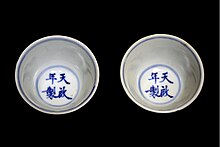Tianqi Emperor
| Tianqi Emperor 天啓帝 | |||||||||||||||||
|---|---|---|---|---|---|---|---|---|---|---|---|---|---|---|---|---|---|
 Palace portrait on a hanging scroll, kept in the National Palace Museum, Taipei, Taiwan | |||||||||||||||||
| Emperor of the Ming dynasty | |||||||||||||||||
| Reign | 1 October 1620 – 30 September 1627[a] | ||||||||||||||||
| Enthronement | 1 October 1620 | ||||||||||||||||
| Predecessor | Taichang Emperor | ||||||||||||||||
| Successor | Chongzhen Emperor | ||||||||||||||||
| Born | 23 December 1605 | ||||||||||||||||
| Died | 30 September 1627 (aged 21) Palace of Heavenly Purity, Forbidden City, Shuntian Prefecture, North Zhili, Ming dynasty | ||||||||||||||||
| Burial | De Mausoleum, Ming tombs, Beijing | ||||||||||||||||
| Spouse | |||||||||||||||||
| |||||||||||||||||
| House | Zhu | ||||||||||||||||
| Dynasty | Ming | ||||||||||||||||
| Father | Taichang Emperor | ||||||||||||||||
| Mother | Empress Dowager Xiaohe | ||||||||||||||||
| Chinese name | |||||||||||||||||
| Traditional Chinese | 天啓帝 | ||||||||||||||||
| Simplified Chinese | 天启帝 | ||||||||||||||||
| |||||||||||||||||

The Tianqi Emperor (23 December 1605 – 30 September 1627), personal name Zhu Youjiao (朱由校), was the 16th emperor of the Ming dynasty, reigning from 1620 to 1627.[2] He was the eldest son of the Taichang Emperor and an elder brother of the Chongzhen Emperor, who succeeded him. "Tianqi", the era name of his reign, means "heavenly opening".[3]
Biography
[edit]Zhu Youjiao became emperor at the age of 15, following the death of his father, the Taichang Emperor, who ruled less than a month.[3] He did not pay much attention to state affairs, and was accused of failing in his filial duties to his late father by not continuing the latter's wishes. It is possible that Zhu Youjiao suffered from a learning disability or something more. He was illiterate[3] and showed no interest in his studies. However, he was an outstanding carpenter and craftsman, often spending vast amounts of time on woodworking and instructing his servants to sell his creations undercover on the market just to see how much they were worth.
Because the Tianqi Emperor was unable to read court memorials and uninterested in state affairs, the court eunuch Wei Zhongxian[2] and the emperor's wet nurse Madam Ke seized power and controlled the Ming imperial court, with the Tianqi Emperor as merely a puppet ruler.[3] The Tianqi Emperor apparently devoted his time to carpentry.[2] Wei Zhongxian took advantage of the situation and began appointing the people he trusted to important positions in the imperial court. Meanwhile, Madam Ke sought to retain power by removing all other women from the emperor's harem by locking away the emperor's concubines and starving them to death. It is believed that he had two private palaces; one for his female lovers and one for his male lovers.[4][failed verification]
One Confucian moralist group, the Donglin Movement, expressed distress at the conditions of the government.[5] In response, the imperial court, under Wei Zhongxian's control, covertly ordered the execution of a number of officials associated with the Donglin Movement. Living conditions worsened during the Tianqi Emperor's reign. The Ming dynasty also faced several popular uprisings.

The Tianqi Emperor died heirless on 30 September 1627 due to his only son having died in the Wanggongchang Explosion and was succeeded by his fifth and sole surviving brother, Zhu Youjian. Zhu Youjian was enthroned as the Chongzhen Emperor.
Family
[edit]
Consorts and issue
[edit]- Empress Xiao'aizhe, of the Zhang clan (孝哀悊皇后 張氏; 1610–1644), personal name Yan (嫣)
- Zhu Ciran, Crown Prince Huaichong (懷衝皇太子 朱慈燃; 4 November 1623), first son
- Consort Hui, of the Fan clan (慧妃 范氏), later Imperial Noble Consort
- Princess Yongning (永寧公主; 1622–1624), personal name Shu'e (淑娥), first daughter
- Zhu Ciyu, Crown Prince Daohuai (悼懷皇太子 朱慈焴; 1623–1624), second son
- Consort Rong, of the Ren clan (容妃 任氏), later Imperial Noble Consort
- Zhu Cijiong, Crown Prince Xianhuai (獻懷皇太子 朱慈炅; 31 October 1625 – 30 May 1626), third son, died during the Wanggongchang Explosion
- Consort Gonghuichun, of the Duan clan (恭惠純妃 段氏; 10 May 1607 – 3 July 1629)
- Consort Cheng, of the Li clan (成妃 李氏; 1605 – 21 December 1637)
- Princess Huaining (懷寧公主; 1624), personal name Shumo (淑嫫), second daughter
- Consort Daoshunyu, of the Zhang clan (悼順裕妃 張氏; 22 August 1606 – 16 September 1623)
- Consort Liang, of the Wang clan (良妃 王氏)
- Noble Lady, of the Feng clan (貴人 馮氏)
- Noble Lady, of the Hu clan (貴人 胡氏; d. 1623)
See also
[edit]Notes
[edit]- ^ Dates given here are in the Gregorian calendar.
- ^ Initially conferred by the Chongzhen Emperor
- ^ Changed by the Chongzhen Emperor
References
[edit]- ^ 《崇禎長編》卷二指熹宗最初謚號為達天禪道敦孝篤友章文襄武靖穆莊勤哲皇帝,後由崇禎帝親自改哲為悊。《說文解字》:「悊,敬也。」《說文解字》:「哲,知也。悊,哲或從心。」
- ^ a b c "Tianqi". Encyclopædia Britannica. 2008.
- ^ a b c d "Zhu Yujiao – The Tianqi Emperor". Retrieved 2014-03-22.
- ^ "History of Homosexuality". china.org.cn. Shanghai Star. Archived from the original on November 19, 2003. Retrieved 26 November 2016.
- ^ "Donglin". Encyclopædia Britannica. Retrieved 2014-03-22.
